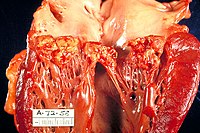
Photo from wikipedia
BACKGROUND Insertion of an external ventricular drain (EVD) is a common neurosurgical procedure which may lead to serious complications including infection. Some risk factors associated with EVD infection are well… Click to show full abstract
BACKGROUND Insertion of an external ventricular drain (EVD) is a common neurosurgical procedure which may lead to serious complications including infection. Some risk factors associated with EVD infection are well established. Others remain less certain, including specific indications for placement, prior neurosurgery, and prior EVD placement. OBJECTIVE To identify risk factors for EVD infections. METHODS We reviewed all EVD insertions at our institution from March 2015 through May 2019 following implementation of a standardized infection control protocol for EVD insertion and maintenance. Cox regression was used to identify risk factors for EVD infections. RESULTS 479 EVDs placed in 409 patients met inclusion criteria, and 9 culture-positive infections were observed during the study period. The risk of infection within 30 days of EVD placement was 2.2% (2.3 infections/1,000 EVD days). Coagulase-negative staphylococci were identified in 6 of the 9 EVD infections). EVD infection led to prolonged length of stay post-EVD-placement (23 days vs 16 days; P = .045). Cox regression demonstrated increased infection risk in patients with prior brain surgery associated with cerebrospinal fluid (CSF) diversion (HR, 8.08; 95% CI, 1.7-39.4; P = .010), CSF leak around the catheter (HR, 21.0; 95% CI, 7.0-145.1; P = .0007), and insertion site dehiscence (HR, 7.53; 95% CI, 1.04-37.1; P = .0407). Duration of EVD use >7 days was not associated with infection risk (HR, 0.62; 95% CI, 0.07-5.45; P = .669). CONCLUSION Risk factors associated with EVD infection include prior brain surgery, CSF leak, and insertion site dehiscence. We found no significant association between infection risk and duration of EVD placement.
Journal Title: Infection control and hospital epidemiology
Year Published: 2022
Link to full text (if available)
Share on Social Media: Sign Up to like & get
recommendations!